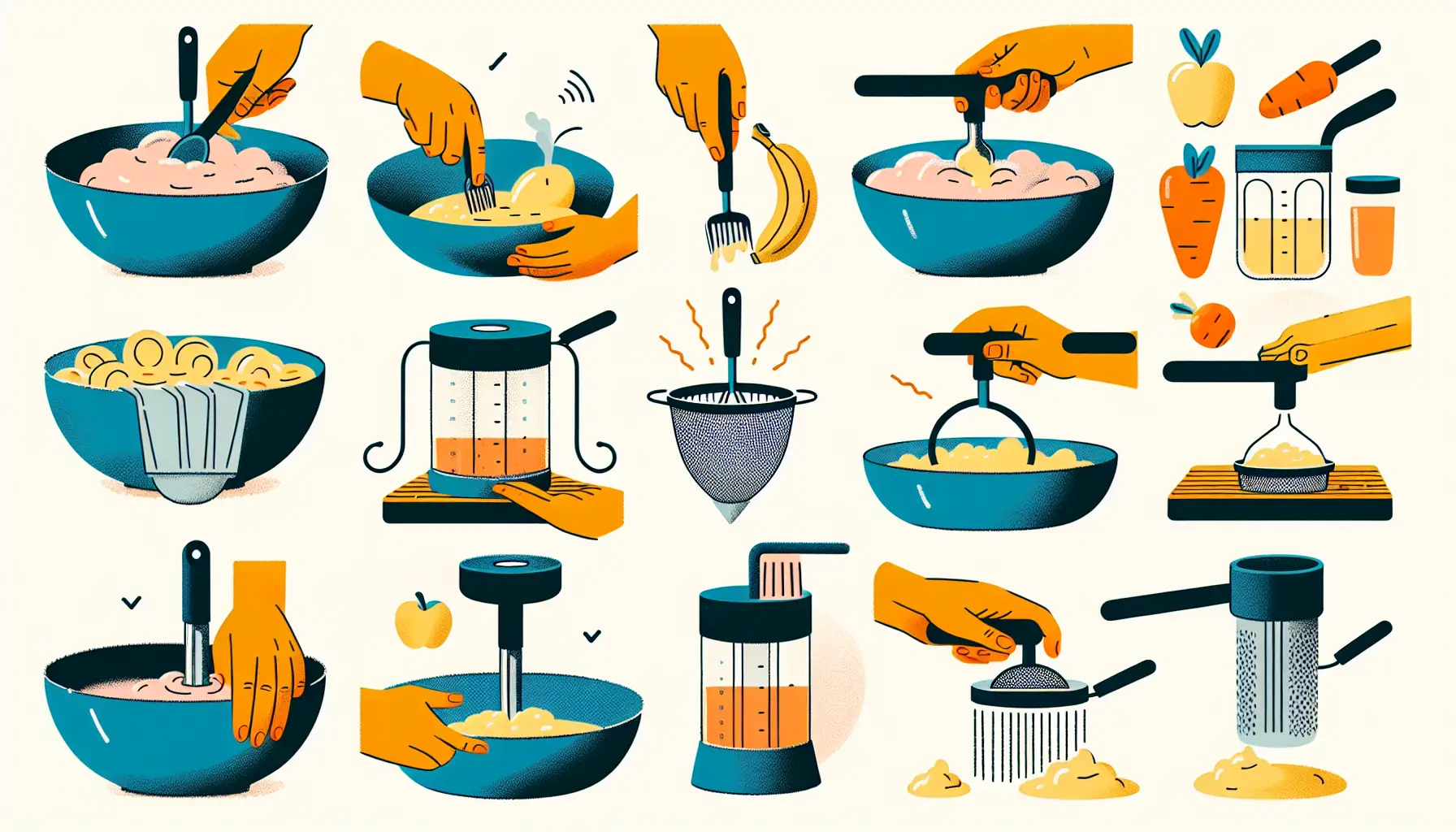Are you a new parent looking to provide homemade pureed food for your little one, but don’t have a blender on hand? Don’t worry, because in this article, you will learn exactly how to puree baby food without a blender! We will explore simple yet effective techniques that will allow you to create smooth, nutritious purees using common kitchen tools. Whether you’re traveling, have limited space, or just prefer an alternative method, we’ve got you covered. So, let’s get started on this culinary adventure for your little bundle of joy!
Using a Fork or Masher
Choose the right food
When pureeing baby food without a blender, it is important to choose the right food that is suitable for mashing or fork-mashing. Examples of suitable foods include cooked fruits like apples or pears, steamed vegetables like carrots or sweet potatoes, and soft-cooked grains like rice or oats. Avoid using foods that are difficult to mash, such as uncooked hard vegetables or tough cuts of meat.
Cook the food
Before pureeing with a fork or masher, it is essential to cook the food thoroughly to ensure it is soft and easily mashable. Steaming, boiling, or baking are common cooking methods to soften the food. Ensure that the food is cooked until it is tender enough to be easily mashed with minimal effort.
Mash the food with a fork
Once the food is cooked, use a fork to start mashing it. Place the cooked food in a bowl and use the fork to gently press and mash the food until it reaches the desired consistency. For more textured purees, leave some small lumps. For smoother purees, continue mashing until the food becomes smooth and free from any lumps.
Use a potato masher
If you prefer a slightly faster and more efficient method, you can opt for a potato masher instead of a fork. Similar to using a fork, place the cooked food in a bowl and use the potato masher to press and mash the food until it achieves the desired texture. The larger surface area of the potato masher can help expedite the mashing process.
Add liquid if needed
If the pureed baby food seems a little too thick or dry, you can add some liquid to achieve the desired consistency. Breast milk, formula, or even water can be used to thin out the puree. Add the liquid gradually while stirring or mashing to ensure you reach the perfect consistency for your baby’s needs.
Using a Food Mill
Prepare the food
To begin the pureeing process using a food mill, start by preparing the food you wish to puree. Peel and chop the fruits or vegetables into small, manageable pieces. This ensures that they cook evenly and can be easily processed through the food mill.
Cook the food
After preparing the food, cook it until it becomes soft and tender. This can be done by steaming, boiling, or baking, depending on the type of food you are working with. It is important to fully cook the food to ensure it is safe and easy to process.
Fill the food mill
Once the food is cooked, fill the food mill with the cooked pieces. Ensure that the food mill is securely attached to a bowl or another receptacle that can catch the pureed food as it is processed.
Operate the food mill
Using a food mill typically involves rotating a handle while simultaneously pushing the food through a perforated plate. This action will strain and puree the cooked food, leaving behind any skins, seeds, or unwanted textures. Continue turning the handle until all the food has been processed through the food mill.
Adjust the consistency
After pureeing the food with a food mill, assess the consistency of the puree. If it is too thick, you can add a small amount of liquid, such as breast milk or water, to achieve the desired thickness. Stir the liquid into the puree until it is well incorporated. Remember to always test the temperature of the puree before feeding it to your baby.
Using a Food Processor
Select the right food processor
When pureeing baby food with a food processor, it is important to choose the right appliance for the job. Look for a food processor that has a small bowl or a mini food processor specifically designed for processing small amounts of food. This ensures that the food is evenly processed and can be easily managed.
Prepare the food
Before using the food processor, prepare the food by peeling, chopping, and cooking it until it is soft and tender. Starchy foods like potatoes, sweet potatoes, or carrots should be cooked until they are easily pierced with a fork or knife.
Process the food
Once the food is cooked, transfer it to the food processor. Secure the lid and pulse the food processor until the food reaches the desired consistency. For smoother purees, blend for a longer duration. If you prefer a more textured puree, pulse the food processor for a shorter period of time.
Adjust the texture
After processing the food, check the texture of the puree. If it is too thick, you can add a small amount of liquid, such as breast milk or water, to achieve the desired texture. Start by adding a little liquid at a time while the food processor is running, until you reach the desired consistency.
Add liquid if necessary
If the puree still appears too thick or dry, you can add additional liquid to achieve the desired consistency. Be cautious not to add too much liquid at once, as it can make the puree too runny. Gradually add small amounts of liquid while blending, until the puree is smooth and easily spoonable.
Using a Mortar and Pestle
Choose a suitable mortar and pestle
When using a mortar and pestle to puree baby food, it is important to choose one that is suitable for the job. Opt for a mortar and pestle made from a material like ceramic or stone, as they are less likely to absorb flavors or odors from the food. Ensure the mortar has enough depth to accommodate the amount of food you are pureeing.
Prepare the food
Begin by preparing the food you wish to puree. Peel and chop the fruits or vegetables into small, manageable pieces. This will make it easier to crush and grind the food into a puree using the mortar and pestle.
Crush the food with the pestle
Place the prepared food into the mortar and use the pestle to crush and grind it. Apply firm pressure and use a circular motion with the pestle to break down the food. Continue this process until the food starts to resemble a paste or puree.
Grind the food into a puree
Once the food is partially crushed, continue grinding it with the pestle in the mortar. Utilize both grinding and crushing motions to further break down the food into a smooth and consistent puree. Be patient, as this method may require more effort and time compared to other pureeing techniques.
Add liquid if desired
If you find that the puree is too thick or dry, you can add some liquid to achieve the desired consistency. Pour a small amount of liquid, such as breast milk or water, into the mortar while continuing to grind and mix the puree. Add the liquid gradually until you reach the desired texture.
Using a Hand Blender
Gather the necessary tools
Before starting the pureeing process with a hand blender, make sure you have all the necessary tools within reach. This includes a hand blender or immersion blender, a deep container or bowl for mixing, and the ingredients you wish to puree.
Prepare the food
To begin, prepare the food you want to puree by peeling, chopping, and cooking it until it is soft and tender. Ensure the food is cut into small, manageable pieces to make the blending process more efficient.
Transfer the food to a bowl
Once the food is cooked, transfer it to a deep container or bowl. This will make it easier to blend and control the texture of the puree. Make sure the container is large enough to accommodate the hand blender without splattering food outside the container.
Blend the food with the hand blender
Insert the hand blender into the container with the food and turn it on. Move the hand blender around the container, ensuring that all the food is pureed evenly. Blend until the desired consistency is achieved, whether that is a smooth puree or a slightly chunky texture.
Adjust the consistency
After blending the food, assess the consistency of the puree. If it is too thick, you can add a small amount of liquid, such as breast milk or water, to achieve the desired thickness. Blend the liquid into the puree again until it reaches the desired consistency.
Using a Potato Ricer
Choose the right potato ricer
When using a potato ricer to puree baby food, it is important to choose one that is appropriate for the task at hand. Look for a potato ricer with fine-sized holes to ensure that the puree is smooth and free from any chunks. Additionally, consider the size and handle comfort of the ricer to ensure ease of use.
Prepare the food
Before using the potato ricer, prepare the food by peeling, chopping, and cooking it until it is soft and tender. The food should be cooked to a consistency that allows it to be easily pressed through the ricer’s holes.
Fill the potato ricer
Once the food is cooked, place a small portion into the potato ricer. Make sure not to overfill it to avoid putting excess strain on the ricer. Gently press the handles together to force the food through the small holes, resulting in a smooth and mashed puree.
Squeeze the handles to puree
With the food in the potato ricer, squeeze the handles together to exert pressure on the food. The food will be forced through the small holes, resulting in a finely pureed texture. Repeat this process until all the food has been passed through the ricer.
Thin out the puree if necessary
If the puree appears too thick, you can add a small amount of liquid to achieve the desired consistency. Mix the liquid into the puree using a spoon until it reaches the desired thickness, ensuring there are no lumps. Adjust the amount of liquid added according to your preference and your baby’s needs.
Using a Fork and Sieve
Get a fine mesh sieve
To start pureeing baby food using a fork and sieve, ensure you have a fine mesh sieve readily available. The sieve should be small and have fine mesh to strain the food effectively while retaining the puree.
Cook and prepare the food
Before pureeing, cook and prepare the food by peeling, chopping, and cooking it until it is soft and tender. Cut the food into small pieces that are easy to mash with a fork.
Mash the food with a fork
Using a fork, begin mashing the cooked food in a bowl. Continuously mash and stir the food until it reaches a smooth, uniform texture. This method allows you to control the texture of the puree while incorporating air for a lighter consistency.
Press the puree through the sieve
Place the fine mesh sieve over a clean bowl or container, ensuring it is stable. Slowly pour the mashed puree into the sieve. Use the back of a spoon or fork to press the puree against the mesh, pushing it through to strain out any remaining solids or lumps.
Add liquid as desired
Once the puree has been strained through the sieve, assess its consistency. If it seems too thick, you can add a small amount of liquid, such as breast milk or water, to achieve the desired consistency. Add the liquid gradually, stirring the puree until it is well incorporated.
Using a Whisk
Select the right type of whisk
To puree baby food using a whisk, it is important to choose the right type of whisk. A standard balloon whisk or a flat whisk can both be effective for this purpose, depending on personal preference. Ensure that the whisk has a comfortable handle for easy grip.
Cook and prepare the food
Before whisking, cook and prepare the food by peeling, chopping, and cooking it until it is soft and tender. Cut the food into small pieces that are easier to mix and whisk.
Mash the food with a fork
Using a fork, start mashing the cooked food in a bowl. Continue mashing and stirring until the food is smooth and ready for further processing with the whisk. Mashing the food beforehand will make the whisking process more efficient.
Whisk the food to a smooth consistency
Transfer the mashed food to a deep bowl or container. Take the whisk and vigorously mix the food, ensuring that there are no lumps and that it reaches a smooth consistency. Be patient and thorough with the whisking to achieve the desired texture for your baby’s puree.
Adjust the thickness
After whisking the food, assess the thickness of the puree. If it appears too thick, you can add a small amount of liquid, such as breast milk or water, to achieve the desired thickness. Gradually add the liquid while whisking until the puree reaches the desired consistency.
Using a Stick Blender
Choose a stick blender
When using a stick blender, also known as an immersion blender, to puree baby food, choose a reliable and high-quality stick blender that is suitable for blending small amounts of food. Look for one with a detachable blending arm for easy cleaning and storage.
Prepare the food
Before using the stick blender, prepare the food by peeling, chopping, and cooking it until it is soft and tender. Cut the food into smaller pieces to ensure smoother and more efficient blending.
Place the food in a deep container
Transfer the cooked food to a deep container or bowl that can accommodate the immersion blender without splattering the puree outside the container. Avoid using shallow bowls or containers that do not provide enough space for blending.
Puree the food with the stick blender
Insert the stick blender into the container with the food, ensuring that the blades are fully submerged. Turn on the stick blender and move it around the container in an up and down or circular motion. Blend until the food reaches the desired smoothness and there are no visible chunks.
Thin the puree if needed
If the puree appears too thick, you can add a small amount of liquid, such as breast milk or water, to achieve the desired consistency. Blend the liquid into the puree again using the stick blender until it reaches the desired thickness and is well incorporated.
Using a Manual Juicer or Citrus Squeezer
Get a manual juicer or citrus squeezer
To puree certain fruits or squeeze juice without a blender, you will need a manual juicer or citrus squeezer. These handheld devices are designed to extract the juice from fruits like oranges, lemons, or limes, while leaving behind any pulp or seeds.
Prepare the food
Before using the manual juicer or citrus squeezer, prepare the fruit by washing it thoroughly and cutting it in half. Remove any seeds, as they can be bitter or hard to puree.
Juice the food
Place one half of the fruit into the manual juicer or citrus squeezer, ensuring that the cut side is facing down. Squeeze and apply pressure to the handles or levers of the juicer, extracting the juice from the fruit. Repeat this process with the other half of the fruit if needed.
Mash the remaining pulp
Once you have extracted the juice, remove the leftover pulp from the juicer. Use a fork or spoon to mash and break down the remaining pulp into a smoother consistency. This will create a puree-like texture, similar to the consistency achieved through other pureeing methods.
Adjust the consistency
After mashing the pulp, assess the consistency of the puree. If it appears too thick or dry, you can add a small amount of liquid, such as breast milk or water, to achieve the desired consistency. Mix the liquid into the puree until it reaches the desired texture.
In conclusion, there are various methods and tools available for pureeing baby food without a blender. Whether you choose to use a fork or masher, food mill, food processor, mortar and pestle, hand blender, potato ricer, fork and sieve, whisk, stick blender, or manual juicer, each method offers its own advantages and techniques. By following the outlined steps for each method, you can easily create homemade purees for your baby that cater to their specific needs and preferences. Remember to consider the texture and consistency desired, and adjust accordingly by adding liquid if needed. With these methods at your disposal, you can confidently embark on your baby’s pureeing journey and provide them with nutritious and delicious food options.





